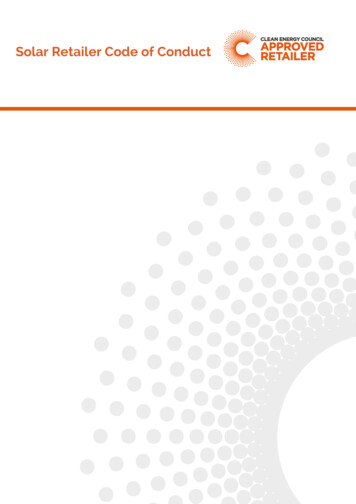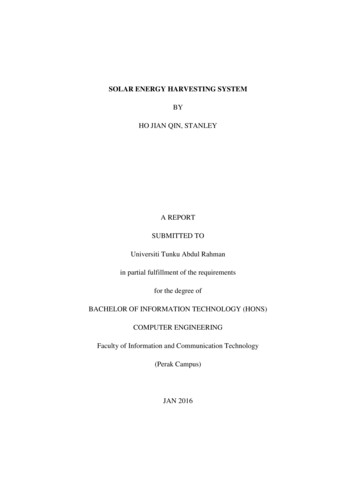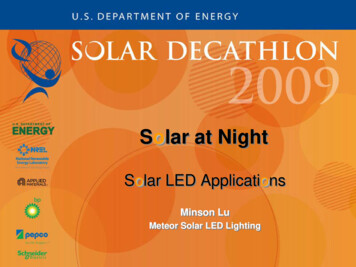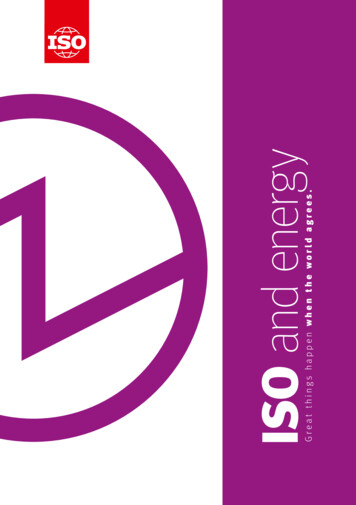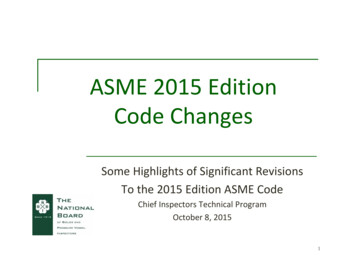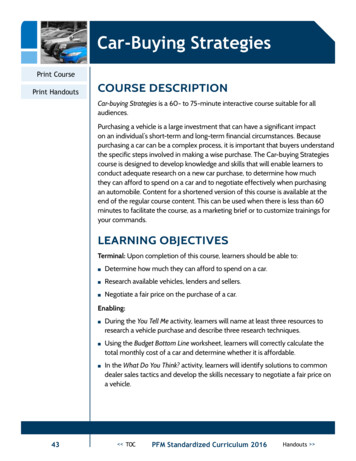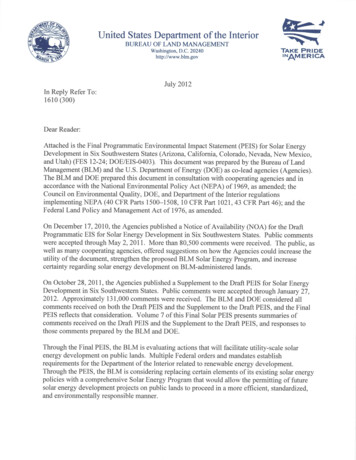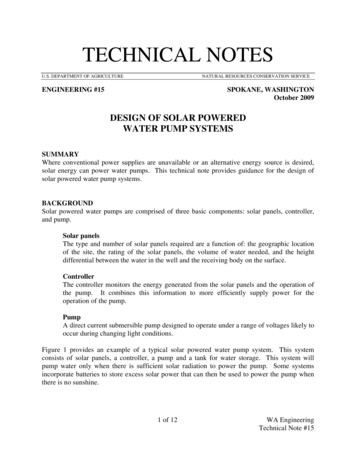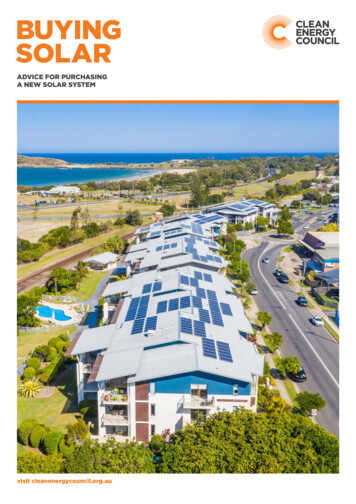
Transcription
BUYINGSOLARADVICE FOR PURCHASINGA NEW SOLAR SYSTEMvisit cleanenergycouncil.org.au
INTRODUCTIONABOUT THECLEAN ENERGYCOUNCILTHE CLEAN ENERGY COUNCIL ISTHE PEAK BODY FOR THE CLEANENERGY INDUSTRY IN AUSTRALIAWe are a not-for-profit organisation committed toaccelerating the transformation of Australia’s energysystem to one that is smarter and cleaner. We havea strong focus on raising standards and maintainingintegrity within the industry so consumers can buy withconfidence and proudly contribute to Australia’s cleanenergy revolution.KANE THORNTONCHIEF EXECUTIVECLEAN ENERGYCOUNCILThere are several ways a company or an individual canbe associated with the Clean Energy Council, throughmembership or as part of one of our complianceprograms.APPROVED SOLAR RETAILERCongratulations on your decision to join the rooftop solarrevolution!Australia is a world leader in the installation of rooftop solar,with millions of Australian households taking advantage of ourwonderful weather to generate their own electricity.But deciding to install a rooftop solar system is a major decisionfor any household. It is therefore extremely important to do yourhomework and learn about the installation process before takingthe plunge.This guide is designed to give you all the information you need tomake an informed decision about purchasing a new rooftop solarsystem. Whether it’s understanding how solar works, engaging asolar retailer or learning about the installation process, the guidewill answer any questions you have about rooftop solar.I hope that you will find this guide useful and that it will help youdecide to join the millions of Australians who have reduced theirelectricity bills and greenhouse gas emissions while makinga significant contribution to Australia’s transition to a cleanenergy future.The Clean Energy Council Solar Retailer Code of Conductis a way for solar businesses to show their commitmentto responsible sales and marketing activities and solarindustry best practice by becoming a Clean EnergyCouncil Approved Solar Retailer.The Code of Conduct isauthorised by the Australian Competition and ConsumerCommission.SOLAR ACCREDITATIONClean Energy Council Accreditation recognises individualelectricians who have undertaken the necessary trainingto design and install solar, batteries and other renewableenergy systems.MEMBERSHIPClean Energy Council members receive a range ofexclusive benefits, including invitations and discounts toattend events and opportunities to participate in policysetting forums.It is important to note, that while Clean Energy CouncilMembers are expected to uphold a Member Code ofConduct, membership with the Clean Energy Councilis not associated with any consumer guarantees orcompliance programs.Solar buying guide 1
UNDERSTANDINGSOLARWhen the sun is shining, solar panelsconvert sunlight into DC (directcurrent) electricity. The solar inverterconverts this electricity into AC(alternating current) power for usein your home. Your home appliances(fridge, dishwasher, pool pumps etc.)use this power instead of drawingpower from the electricity grid.Solar PV modulesSupplying DC power1PVelectricityoutput(DC) 2InverterThe inverter changesthe solar DC power into230V AC power suitablefor your householdappliances and feedinginto the grid2Solar buying guide3Switchboard(electricity to house)Your home useselectricity firstly fromthe solar PV modules,with additional demandsupplied from the grid4MeterThe metermeasures yourelectricityproduction andconsumption5Electricitynetwork (grid)Excess electricitymay be exportedback into theelectricitynetwork
The most common form ofsolar installed in Australiais grid-connected solarSolar systems are most effective when they are well positioned(north-facing is optimal, but not essential) and exposed toenough sunlight without obstruction by shade caused from trees,power lines or other structures.Depending on the amount of available sunlight, a gridconnected solar system will operate in one of the following ways.DURING DAYLIGHT HOURS, THE SOLARSYSTEM IS PRODUCING MORE ENERGY THANTHE HOUSEHOLD IS CONSUMING/USINGIn this scenario, household appliances will be powered by thesolar system. The excess solar generated by the system is fedback (exported) into the electricity grid.If you are feeding excess electricity generated by the solarsystem back into the grid, your energy retailer may pay youthrough a feed-in tariff (see page 5 for more information onfeed-in tariffs).DURING DAYLIGHT HOURS, THE SOLARSYSTEM IS PRODUCING LESS ENERGY THANTHE HOUSEHOLD IS CONSUMING/USINGIn this scenario, the solar system will power household appliancesequal to the amount of power being generated. Additional powerrequired will be drawn directly from the electricity grid.Solar generation, consumption and export is tracked andrecorded through a smart meter, providing the data for electricitybilling.OTHERTYPESOF SOLARSYSTEMSGRID-CONNECT WITH BATTERYBACK-UPWith solar customers in many states nowreceiving a low price for electricity sold backto the grid, battery back-up systems can be aviable alternative as they use the electricitystored during the day to run your house atnight. They may also have the capability tosupply power during power outages.STAND-ALONE SOLAR SYSTEMSStand-alone systems are not connected tothe electricity grid and typically are installedin remote areas where there is limitedconnection to the grid or areas of lowelectricity demand. Unlike grid-connectedsolar systems, these systems must havebatteries or backup generation to providesupply at night. In many cases, they willalso include a diesel or petrol generator tosupplement energy supply.Solar buying guide 3
UNDERSTANDINGYOUR ENERGYCONSUMPTIONTO DETERMINE IF AN INVESTMENT IN SOLARIS RIGHT FOR YOU, IT’S IMPORTANT TOUNDERSTAND YOUR ENERGY USAGE. YOURELECTRICITY RETAILER WILL BE ABLE TOHELP YOU WITH THIS INFORMATION.UNDERSTANDING HOW MUCH SOLAR POWERYOU WILL BE ABLE TO USE THROUGHOUTTHE DAY WILL HELP YOU SELECT ANAPPROPRIATELY SIZED SYSTEM AND ENSUREYOU ARE GETTING A RETURN ON YOURINVESTMENT.Your electricity retailer should outline your average daily usagein kilowatt hours (kWh) on your electricity bill. It is importantto have this value and your electricity bill in front of you whenmaking first contact with a solar retailer so you can work togetherto design a system that will ensure you maximise the benefits ofyour new rooftop solar system.4Solar buying guideKeep in mind that your electricity usage will change betweenseasons, so you may want to look at a bill from different times ofthe year to compare.The most benefit to be gained from solar is through “selfconsumption” – that is, consuming the power your solar systemgenerates instead of drawing power from the grid.If you (or your family) are not home during the day, you canstill make the most of your system by altering or tweaking theway you consume energy or by running appliances during peakdaylight hours.Similarly, self-consumption is still viable in the morning andafternoon where panels are installed east- or west-facing. Thesesystems will benefit from generation as the sun rises in themorning and sets in the afternoon.
THE RIGHTSOLAR SYSTEMFOR YOUHOW WELL DO YOUKNOW YOUR ROOF?Despite what some advertising may tellyou, there is no “one size fits all” solutionfor solar. And the cheapest system is oftennot the best option. Every home is different,and the requirements can vary significantlydepending on your circumstances.The orientation (degree to north) of yourroof, pitch (slope or angle), available space,amount of shade and even the type of roof(tile, tin, concrete etc.) will impact how youbenefit from solar, or even if solar is an optionfor you.For example, the available roof space on yourproperty may only allow for a small system.This may impact the solar system’s abilityto generate excess solar power. In this case,you will be more reliant on consuming theelectricity you generate rather than exportingit to the grid. Speak with your solar retailerabout designing a solar system for maximumself-consumption.Any excess power you generate may be sent back to the grid, for whichyou may be paid a feed-in tariff by your electricity retailer.If the available roof space on your propertyallows for a larger solar system, you maygenerate excess solar power and benefit froma feed-in tariff.Feed-in tariffs differ from state to state and from retailer to retailer. Insome states, the government regulates a minimum rate, while in others itis up to you to negotiate a deal with your electricity retailer.You might also be considering a battery (nowor in the future) so the excess solar generatedcan be stored for later use.There may also be changes to your standard electricity rates or chargesafter the installation of a solar system.For more information on battery installations,visit the Clean Energy Council websitecleanenergycouncil.org.au/consumersA BIT MORE ON FEED-IN TARIFFSConsider speaking with your electricity retailer to discuss any changesthat may apply from installing solar. You may also want to shop aroundto find out which electricity retailers offer better rates and/or tariffs forsolar customers.Solar buying guide 5
CHOOSING ASOLAR RETAILERWHEN CHOOSING A SOLAR OR STORAGERETAILER AND/OR INSTALLER, IT PAYSTO DO A LITTLE RESEARCH. THE CLEANENERGY COUNCIL RECOMMENDS CHOOSINGAN APPROVED SOLAR RETAILER WHO HASSIGNED ON TO THE SOLAR RETAILER CODEOF CONDUCT AND USES DESIGNERS ANDINSTALLERS WHO ARE ACCREDITED BYTHE CLEAN ENERGY COUNCIL.We also recommend seeking multiple quotes for comparisonand reading product reviews online before making yourdecision.The Clean Energy Council Approved Solar Retailer program isa way for businesses that sell solar and storage to show theircommitment to responsible sales and marketing activities andindustry best practice.Authorised by the Australian Competition and ConsumerCommission (ACCC), the program aims to lift the bar higherthan the minimum requirements set by government andregulations and bring about a better standard of servicewithin the solar industry.The Clean Energy Council has developed an online tool tohelp you find an Approved Solar Retailer in your area. Pleasevisit indan-approved-solar-retailer6Solar buying guideQUESTIONS TO ASKYOUR SOLAR RETAILER123Are you a Clean Energy CouncilApproved Solar Retailer?4Do you provide an additionalwarranty on the installation,workmanship or operation ofthe system?56Will you provide a site-specificdesign and performance estimate?Are your installers accredited bythe Clean Energy Council?What are the warranty terms foreach product or component(i.e. inverter, panels)?If installation plans or design needto change on the day of install,do I have an option to cancel?
WHAT CAN I EXPECT FROM ANAPPROVED SOLAR RETAILER?SOLAR RETAILERCODE OF CONDUCTAs signatories to the Solar Retailer Codeof Conduct, consumers can be confidentthat their Approved Solar Retailer willconduct business in a professional andethical manner.The terms of the code detail specificrequirements which must be adheredto throughout the installation process.This includes a transparent sales process,a site-specific design and performanceestimate, installation by a Clean EnergyCouncil Accredited Installer and bestpractice warranty terms.If you choose an Approved Solar Retailerand something goes wrong or youexperience any issues, the Clean EnergyCouncil can support you.A copy of the code is available onthe Clean Energy Council website.Please visit hoosing-aretailer-or-installerAPPROVED PRODUCTSACCREDITED INSTALLERSApproved Solar Retailers are required toonly sell and install Clean Energy Councilapproved products.Accreditation with the Clean EnergyCouncil recognises individual electricianswho have undertaken the necessarytraining to design and install solar,batteries and other renewable energysystems. Accredited Installers aim towork to industry best practice standards,producing systems that are safe, reliableand meet customer expectations.Through its Product Assurance program,the Clean Energy Council verifies andtests solar and storage products that areeligible to be installed in Australia, basedon their compliance with Australian andinternational standards.The Clean Energy Council works incollaboration with government, electricalsafety regulators, certifiers, networkproviders and product manufacturers toensure that only approved products areinstalled in the Australian market.The Clean Energy Council maintainslistings of products that are eligible to beinstalled, based on their compliance withAustralian and international standards.Our approved product lists cover inverters,PV modules (solar panels) and batteries.To check whether a product is on theClean Energy Council Approved Productslist, please ean Energy Council Accredited Installersmust adhere to the relevant Australianstandards when designing and installingsystems.If you choose an Accredited Installer andrequire assistance during any part of theinstallation process, the Clean EnergyCouncil can support you.We have developed an online tool tohelp you find an Accredited Installer inyour area. You can also search by name,making it easier to identify whether yourinstaller is accredited. Please lar/find-an-installerIn conjunction with the Approved Productlists, the Clean Energy Council also runsa testing and compliance program. Thisencompasses proactive internal audits ofthe database of approved products andtheir relevant certifications and targetedproduct testing.A NOTE ON “TIER 1” PANELS“Tier 1” is a term often used to promotesolar panels; however, it does not reflectproduct quality or performance. The tierrankings are used by Bloomberg NewEnergy Finance Corporation to rank solarpanel manufacturers in terms of theirbankability or financial stability.Solar buying guide 7
QUOTES ANDCONTRACTSTHE CLEAN ENERGY COUNCIL ALWAYSENCOURAGES YOU TO GET MULTIPLEQUOTES FROM DIFFERENT RETAILERS, SOYOU HAVE A GOOD BASIS FOR COMPARISONOF PRICE, SYSTEM SIZE AND PERFORMANCEAS WELL AS CUSTOMER EXPERIENCE.The quote will often form the basis for your contract, so it isimportant that it provides you with the information you need.WHAT SHOULD I LOOK FOR INA QUOTE OR CONTRACT?Your quote should be detailed, professional and include: a site-specific system designA site inspection or home assessment is not essential, and manyretailers will design a system for you using satellite imagery andtechnology. While this way of quoting or selling is very commonand can work well in many cases, it may increase the chances ofunforeseen issues or additional requirements and costs.Any variations to the original system design and cost should beaccepted by you prior to installation. If you do not consent to anyvariations and you are dealing with an Approved Solar Retailer, youare entitled to a full refund as outlined in the Code of Conduct.Before entering any agreement, it is essential to review allaspects of your contract and terms and conditions of sale.The contract should be clear, legible and use plain language. a performance estimateSTCS AND OTHER REBATES an itemised list of components/productsSmall-scale Technology Certificates a clear breakdown of costs, including the total value of anydiscounts or rebatesFederal Government incentives in the form of Small-scaleTechnology Certificates (STCs) help reduce the upfront cost ofinstalling your solar system. STCs should be clearly itemisedwithin your quote to highlight the discount applied. full terms and conditions of sale.Remember that once you have received the quote, you are underno obligation to go ahead with an installation.You should never feel pressured into a purchase. The choice toproceed with a purchase is yours and yours alone, so making sureyou are comfortable with the information you have been providedwith is essential. Have all your questions been answered? Do youunderstand the installation, grid connection and metering process?Have you been informed of any after-sale support available to you?Contracts generated from unsolicited sales (e.g. doorknocking ortelemarketing) must include a cooling-off period. A cooling-offperiod is a safeguard that allows you to change your mind andcancel the contract within a specified period.It is common practice to assign the rights to STCs to yourApproved Solar Retailer or Accredited Installer to reduce theupfront costs of a solar system through a point of sale discount.STCs are calculated by the following factors: type of renewable energy installed (solar, wind or hydro) date of installation rated power output (in kW) of your system postcode (location).SITE INSPECTIONS AND HOME ASSESSMENTSTo assign the rights to STCs, your retailer or installer will askyou to sign a hard copy or digital assignment form. Beforesigning the form, you should ensure it lists the products installedand the name of the CEC Accredited Installer who physicallyattended your home to install your system. You can verify thisby asking to see the installer’s digital accreditation ID card atthe commencement of the installation. The STC form shouldonly be signed once the system has been fully installed andcommissioned.A site inspection or home assessment is a great way foryour solar retailer or installer to clearly determine the uniquerequirements for your solar system.For more information on STCs or to use an online STC calculator,visit or contact the Clean Energy Regulator cleanenergyregulator.gov.au/RETEvery home is different, so a pre-installation inspection is thebest way to accurately identify the optimal location for panels onyour roof, the ideal location for the inverter and any additionalrequirements and associated costs for installation.Some states and territories in Australia offer additional incentivesor rebates. Ask your Approved Solar Retailer whether you areeligible for further incentives or seek further information fromyour state or local government.The Australian Competition and Consumer Commission hasresources for consumers wanting to learn more about theAustralian Consumer Law and unsolicited sales. For moreinformation, visit -door-to-door-sales8Solar buying guide
WE HAVE COMPILED A CHECKLIST TO HELPWHEN REVIEWING A CONTRACT:Company name (of solar retailer)Australian Business Number (ABN)Physical addressContact details (email andtelephone)An itemised list of the goods/products to be supplied/installed,including full specifications of thesystem. Listed goods/productsshould include:ManufacturerModel numberQuantity of each productPower rating of the solar panelsand inverter in kilowatts (kW)A site-specific system design,including:Proposed roof plan, showingthe layout of solar panelsOrientation of the solar panelsin relation to true northThe tilt or angle applied toyour solar panels formaximum efficiencyA system performance estimateshowing the estimated energyproduced for each month ofsolar generationThe total price of all goods andservices, itemised and includingthe total value of any discounts,incentives or rebates.Any additional costs not coveredin the original quote, resultingfrom site conditions or specialcircumstances beyond the control ofthe retailer.Consumer guarantees and warrantyinformation for relevant productsand components, as well as anywarranty terms for workmanship,installation or the operation andperformance of the system.Terms and conditions of saleClean Energy Council Approved Solar Retailers must include certain information as part of their final quote and contract.To view these requirements in the Code of Conduct, please visit cleanenergycouncil.org.au/industry/retailersSolar buying guide 9
THEINSTALLATIONPROCESS10Solar buying guide
GRID CONNECTIONAPPLICATIONWhat is a grid-connection application?As part of the connection process, your electricity distributor will check ifthe local electricity network can support your new solar system.Depending on the size of your system and the characteristics of the localgrid you are connecting to, the technical requirements of your distributormay vary.Who are electricity distributors?Electricity distributors own and manage the infrastructure, power polesand wires that deliver power to homes and businesses. You cannotchoose your distribution company.There are many distribution companies across Australia. To make iteasier, we have sorted each electricity distributor by state:ACTEvoenergy, Essential EnergyNSWEssential Energy, Ausgrid, Endeavour EnergyNTPower and Water CorporationQLDEnergex, Ergon EnergySASA Power NetworksTASTasNetworksVICPowercor, CitiPower, Jemena, AusNet,United EnergyWAWestern Power, Horizon Power, SynergyDo I need a grid-connection approval prior to installation?Yes. Your electricity distributor can reject a grid connection application ifthe proposed system does not suit the requirements of their network. Inthis case, they will provide recommendations on what needs to changeand advise you and your solar retailer of the options available.How long does it take to receive connection approval?Timelines can vary significantly between distributors. Depending on thedistributor, it can take up to 30 business days. You can also contact yourdistributor directly to find out how long it typically takes to receive anoutcome.In some circumstances, a more detailed grid-connection application isrequired. Due to the additional time needed to check network conditions,it may take longer to receive an outcome.QUESTIONSTO ASK YOURSOLAR RETAILER1Will you be submitting thegrid-connection applicationon my behalf?2Do I need to sign the gridconnection applicationform?3Is there a cost associatedwith my grid-connectionapplication?456Can I be sent a receipt of thesubmission?7If my distributor rejects thegrid connection application,am I entitled to a refund?8Can I be sent a copy of theapproval notice?How long will the gridconnection approval take?Who can I contact if Ihave questions about theapplication?What happens once I receive grid-connection approval?You are ready to proceed with the installation of your rooftop solar system.Solar buying guide 11
SYSTEMINSTALLATIONIt is important that you are home for the installationof your system so you can meet your AccreditedInstaller, make sure you are present to sign-off onunforeseen changes required and learn how tooperate and monitor your new solar system.Learning how to monitoryour solar systemYour installer’s accreditationUpon installation, your Accredited Installer shouldprovide you with a short demonstration on how touse and monitor your solar system. That way, if youhave any questions about the operation of the system,they can be answered before the installer leaves yourproperty.Once your installer arrives at your property, ask tocheck their digital accreditation ID card prior toinstallation.Accreditation with the Clean Energy Councilrecognises electricians who have undertaken thenecessary training to design and install solar,batteries and other renewable energy systems.The ID card is digital and should be shown to youon a phone or tablet. It will display the followinginformation: a photo of the installer accreditation number expiry date types of accreditation heldThe “last opened” dateshould show the current dayor the previous 24 hours.At least one installerpresent on the propertyshould be a Clean EnergyCouncil AccreditedInstaller and will be ableto show you their IDcard. If your installeris unable to providetheir accreditationID, contact your solarretailer about youroptions.Most systems will have monitoring functionalityavailable, which is a great way to understand how yoursystem is performing over time.DocumentationAppropriate documentation will be essential if youneed to make warranty or insurance claims. A usermanual should be provided by the installer on the dayof installation.It is the responsibility of your solar retailer to ensurethat you have been provided with appropriatedocumentation.You should receive:comprehensive information for safe andeffective operation, maintenance andoptimisation of your solar systemthe shutdown and isolation procedure foremergencies and maintenancea recommended maintenance schedule forthe systema copy of the installation commissioningsheeta Certificate of Electrical Safety or equivalentin your state/territorywarranty information for each productinstalled at your propertyhandbooks and product information for allequipment supplieda list of actions to be taken in the event ofan earth fault alarm.12 Solar buying guide
CONFIGURING YOURMETER FOR SOLARYour electricity meter will either need to be replaced or reconfigured for solar import/export.Your solar retailer may offer to submit a request to your electricity retailer to configure yourelectricity meter on your behalf.We recommend speaking with your solar retailer to discuss how the request will be submitted andwho is responsible.How do I submit a request to have my electricity meter configured for solar?To get the ball rolling, you will need to contact your electricity retailer (the company who bills youfor your electricity). Some electricity retailers allow you to submit your request via their website.Others may simply ask you to send them an email.Are there any documents that I need to submit with my request?Most electricity retailers will ask you to include a number documents with your request. Contactyour solar retailer to obtain a copy of these documents:All states: Confirmation of grid-connection approval All states: Electrical Work Request or equivalent document for your state or territory ACT: Certificate of Electrical SafetyNSW: Certificate of Compliance for Electrical WorkNT: Certificate of ComplianceQLD: Certificate of Testing and Safety, Certificate of Testing and ComplianceSA: Certificate of ComplianceTAS: Certificate of Electrical ComplianceVIC: Certificate of Electrical SafetyWA: Electrical Safety CertificateHow long will it take to have my electricitymeter configured for solar?On 1 February 2019, the Australian Energy Market Commission introduced new rules requiringelectricity retailers to fulfil meter installation/configuration requests within certain timeframes.Presently, electricity retailers and consumers must come to a mutual agreement to determinean adequate timeframe for meter installation. Contact your electricity retailer to discuss meterconfiguration and timeframes for completion.If your solar retailer submitted your metering request for you, contact them for an update. It is likelythat your solar retailer was given a reference number when the request was submitted.You are encouraged to check your first electricity bill after your solar system has been installed.If you do not see a meter fee or reference to a solar feed-in tariff, contact your electricity retailer.Solar buying guide 13
MAINTENANCEAND SERVICINGLIKE ALL ELECTRICALEQUIPMENT, MAINTENANCEOF YOUR SOLAR SYSTEMIS ENCOURAGED, AND YOUSHOULD FOLLOW THEMAINTENANCE SCHEDULEPROVIDED BY YOUR SOLARRETAILER OR INSTALLER.Just like running a car, servicing is the bestway to ensure your solar system keepsoperating safely, correctly and efficiently intothe future.Maintenance or servicing of solar systems isoffered by many Accredited Installers andsolar retailers and can include: panel cleaning and removal of debris system inspection and testing electrical checks to ensure allcomponents are operating as intended reviewing the inverter display panel forrecorded faults checking that access to the isolatorswitches has not been impeded making sure the emergency proceduresfor shutdown and isolation are clearlydisplayed.14 Solar buying guide
Solar buying guide 15
WHAT IF SOMETHINGGOES WRONG?WARRANTIESIf you have an issue with any solar product while it is under warranty, you should first contact your solar retailerto have the product replaced or repaired. If you are unable to contact your retailer, contact the manufacturer.Contact details should be provided on the warranty documentation.If you are not happy with the response you receive from your solar retailer, you can lodge a complaint with therelevant Fair Trading or Consumer Affairs office in your state or territory. They can negotiate on your behalf andarrange mediation where BSITEACTAccess Canberra13 22 WFair Trading13 32 20fairtrading.nsw.gov.auNTConsumer Affairs1800 019 319consumeraffairs.nt.gov.auQLDOffice of Fair Trading13 74 68qld.gov.au/law/fair-tradingSAConsumer and BusinessServices13 18 82cbs.sa.gov.auTASConsumer, Building andOccupational Services1300 654 499cbos.tas.gov.auVICConsumer Affairs1300 558 181consumer.vic.gov.auWAConsumer Protection1300 304 054commerce.wa.gov.au/consumer-protection16Solar buying guide
COMPLAINTS AGAINST CLEAN ENERGYCOUNCIL APPROVED SOLAR RETAILERSIf you need to make a complaint against a company identifyingitself as a Clean Energy Council Approved Solar Retailer, youshould first contact the company directly. If you are not satisfiedwith the response from the company, you can contact theClean Energy Council to investigate any suspected breachesof the Solar Retailer Code of Conduct. You can also lodge yourcomplaint with the Clean Energy Council online mWORKMANSHIP OR INSTALLATIONCOMPLAINTSThe Clean Energy Council aims to resolve complaints involvingworkmanship issues that breach the Accreditation Guidelinesor relevant Australian standards by a Clean Energy CouncilAccredited Installer.This does not extend to solar retailers (sales companies) and onlyapplies to individual tradespeople who hold Clean Energy Councilaccreditation.You may be asked to provide a report and photo evidencesupportin
Your home uses electricity firstly from the solar PV modules, with additional demand supplied from the grid 4 5 2 Solar buying guide When the sun is shining, solar panels convert sunlight into DC (direct current) electricity. The solar inverter converts this electricity into AC (alternating current) power for use in
